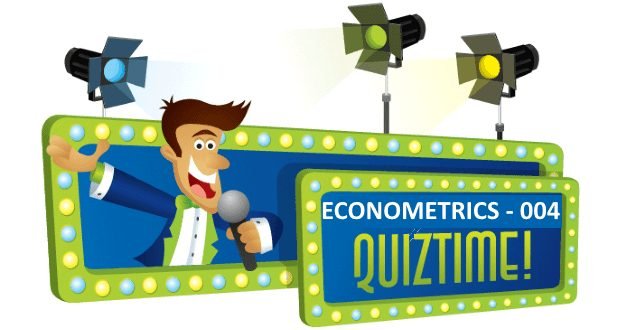500 câu trắc nghiệm Kinh tế lượng – 12C

Tổng hợp 500 câu trắc nghiệm + tự luận Kinh tế lượng (Elementary Statistics). Tất cả các câu hỏi trắc nghiệm + tự luận đều có đáp án. Nội dung được khái quát trong 13 phần, mỗi phần gồm 3 bài kiểm tra (A, B, C). Các câu hỏi trắc nghiệm + tự luận bám rất sát chương trình kinh tế lượng, đặc biệt là phần thống kê, rất phù hợp cho các bạn củng cố và mở rộng các kiến thức về Kinh tế lượng. Các câu hỏi trắc nghiệm + tự luận của phần 12C bao gồm:
SHORT ANSWER. Write the word or phrase that best completes each statement or answers the question. Provide an appropriate response.
1) Describe the Kruskal-Wallis test. What types of hypotheses is it used to test? What assumptions are made for this test?
The Kruskal-Wallis test sums ranks for the sample data ranked as a whole. However, the Kruskal-Wallis test is used to test claims about the differences in means among three or more independent samples, as opposed to the Wilcoxon rank-sum test which looks at claims for two independent samples. The assumptions include: there are at least three random samples; we want to test the null hypothesis that the samples come from the same or identical populations; and each sample has at least five observations.
2) Describe the rank correlation test. What types of hypotheses is it used to test? How does the rank correlation coefficient rs differ from the correlation coefficient r found in Chapter 9?
The rank correlation test uses ranks to measure the strength of the relation between two variables. The rank correlation test is used to test the null hypothesis that there is no correlation between the two variables. In Chapter 9, the correlation coefficient rwas linear. The rank correlation rs, also known as Spearman’s rank correlation coefficient, detects relationships which are non-linear as well as linear.
Use the sign test to test the indicated claim.
3) A researcher wishes to test whether a particular diet has an effect on blood pressure. The blood pressure of 25 randomly selected adults is measured. After one month on the diet, each person’s blood pressure is again measured. For 18 people, the second blood pressure reading was lower than the first, and for 7 people, the second blood pressure reading was higher than the first. At the 0.01 significance level, test the claim that the diet has an effect on blood pressure.
H0: The diet does not have an effect on blood pressure.
H1: The diet has an effect on blood pressure.
Test statistic: x = 7. Critical value: x = 5.
Fail to reject the null hypothesis. There is not sufficient evidence to support the claim that the diet has an effect on blood pressure
4) The waiting times (in minutes) of 28 randomly selected customers in a bank are given below. Use a significance level of 0.05 to test the claim that the population median is equal to 5.3 minutes.
| 8.2 | 8.0 | 10.5 | 3.8 | 6.4 | 5.3 | 7.8 |
| 2.9 | 6.0 | 7.7 | 6.1 | 5.9 | 1.2 | 10.4 |
| 7.3 | 6.9 | 5.8 | 5.1 | 6.2 | 3.1 | 5.8 |
| 11.7 | 4.5 | 6.5 | 9.8 | 7.4 | 2.3 | 7.8 |
H0: median is equal to 5.3 minutes.
H1: median is not equal to 5.3 minutes.
Convert x = 7 to the test statistic z = -2.31. Critical values: z = ±1.96.
Reject the null hypothesis. There is sufficient evidence to warrant rejection of the claim that the population median is equal to 5.3 minutes.
Use the Wilcoxon signed-ranks test to test the claim that both samples come from populations having the same distribution.
5) In a study of the effectiveness of physical exercise in weight reduction, 12 subjects followed a program of physical exercise for two months. Their weights (in pounds) before and after this program are shown in the table. Use a significance level of 0.05 to test the claim that the exercise program has no effect on weight.
| Before | 162 | 190 | 188 | 152 | 148 | 127 | 195 | 164 | 175 | 156 | 180 | 136 |
| After | 157 | 194 | 179 | 149 | 135 | 130 | 183 | 168 | 168 | 148 | 170 | 138 |
Test statistic T = 12.5. Critical value: T = 14.
Reject the null hypothesis that both samples come from the same population distribution
Use the Wilcoxon rank-sum test to test the claim that the two independent samples come from the same distribution.
6)11 female employees and 11 male employees are randomly selected from one company and their weekly salaries are recorded. The salaries (in dollars) are shown below. Use a significance level of 0.10 to test the claim that salaries for female and male employees of the company have the same distribution.
| Female | Male |
| 350 420 470 | 410 460 650 |
| 385 675 520 | 545 720 810 |
| 540 400 550 | 660 500 880 |
| 450 640 | 700 750 |
\({\mu _R}\)= 126.5, \({\sigma _R}\) = 15.2288, R = 90.
Test statistic: z = -2.40. Critical values z = ±1.645.
Reject the null hypothesis. There is sufficient evidence to warrant rejection of the claim that the two populations are identical